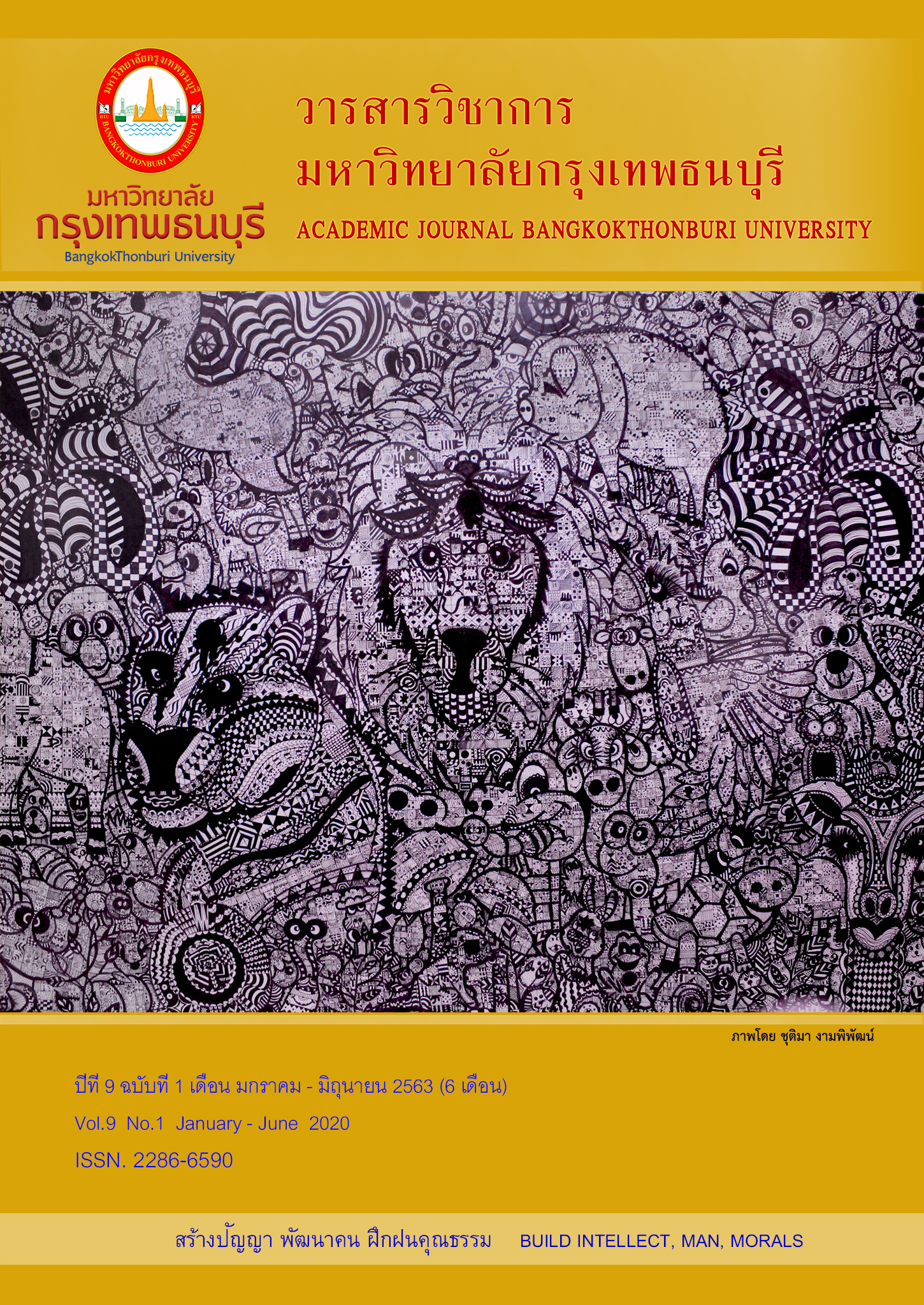The cluster analysis of young fitness customers in Pathum Thani
Main Article Content
Abstract
This research has two objectives which are to study youth fitness customer’s exercise behaviors, and to categorize and identify the work-out characteristics of the youth. This research employ quantitative research methods by survey research. The 340 questionnaires were distributed at the respond rate of 85 percent. The descriptive which are percentage, mean, and standard deviation, as well as the inferential statistics were shown. Also, the factor analysis and cluster analysis, K-Means Clustering were utilized at the end of this paper.
The result shows that the most among sample are female at the average age of 20 as well as at the bachelor degree level. The exercise behavior mostly relates to being healthy at the means of 4.20 and .871 standard deviations. Additionally, there are 6 factors influence youth exercise. Lastly, the groups can be categorized into 6 groups namely “Clear-cut goal and impressive image”, “Self-influence with friends” “Brand and socialize are my type”, “I need some friends”, “I love the gym, you do not need to force me”, “High-end are us, we love exercise”. The further studies suggest that to explore the marketing strategies in the specific groups or even niched market, marketing planning, stress, social pressure factors as well as using statistical techniques to explain the relationship and differences among groups of study.
Article Details
References
การกีฬาแห่งประเทศไทย. (2545). แผนพัฒนากีฬาแห่งชาติ ฉบับที่3 (2545 – 2549). กรุงเทพฯ: ไทยมิตรการพิมพ์.
กรมพัฒนาธุรกิจการค้า. (2562). ธุรกิจฟิตเนส: บทวิเคราะห์ธุรกิจ ประจำเดือน พฤษภาคม 2562. สืบค้นเมื่อ 27 ธันวาคม 2562 จาก https://www.dbd.go.th
กัลยา วานิชย์บัญชา. (2552). การวิเคราะห์ข้อมูลหลายตัวแปร. (พิมพ์ครั้งที่ 4). กรุงเทพฯ: บริษัทธรรมสารจำกัด.
กุลธิดา เหมาเพชร , คมกริช เชาว์พานิช , พรเพ็ญ ลาโพธิ์ . (2555). พฤติกรรมการออกกำลังกายของบุคลากรมหาวิทยาลัยเกษตรศาสตร์ วิทยาเขตกำแพงแสน. กรุงเทพมหานคร: สถาบันวิจัยและพัฒนาแห่งมหาวิทยาลัยเกษตรศาสตร์.
จิราภา พึ่งบางกรวย. (2552). ส่วนประสมตลาดบริการที่มีอิทธิพลต่อการตัดสินใจใช้บริการฟิตเนสเซ็นเตอร์ ในกรุงเทพมหานคร. คณะบริหารธุรกิจ มหาวิทยาลัยศรีปทุม: กรุงเทพฯ.
เดชา เดชานพพงศ์. (2559). แนวทางการจัดการและองค์ประกอบมาตรฐานของฟิตเนสเซ็นเตอร์เอกชนขนาดย่อม. วิทยานิพนธ์ วิทยาศาสตรมหาบัณฑิต สาขาวิชาวิทยาศาสตร์การออกกำลังกาย และการกีฬา. มหาวิทยาลัยบูรพา.
ชาญชลักษณ์ เยี่ยมมิตร. (2556). การศึกษาการออกกำลังกายของนักศึกษามหาวิทยาลัยราชภัฏรำไพพรรณี ปีการศึกษา 2554. ปริญญานิพนธ์. กศ.ม.(พลศึกษา) บัณฑิตวิทยาลัย. มหาวิทยาลัยศรีนครินทรวิโรฒ.
ณัฐพล พุ่มศิริ. (2562). การวิเคราะห์องค์ประกอบเชิงสำรวจการเพิ่มผลสัมฤทธิ์ให้องค์กรด้วยการจัดการความรู้ในภาคธุรกิจอุตสาหกรรม. วารสารวิชาการ มหาวิทยาลัยธนบุรี, 8(2), 75-89.
นิติพงษ์ ส่งศรีโรจน์. (ม.ป.ป.). การวิเคราะห์องค์ประกอบ. สืบค้นเมื่อ 7 ธันวาคม 2562 จาก http://www.nitiphong.com/
พชร พันธวัชโกศล. (2559). การจัดพื้นที่ใช้ประโยชน์ภายในฟิตเนสเซ็นเตอร์: กรณีศึกษาฟิตเนสเฟิร์ส สาขาเดอะพรอมานาด กรุงเทพมหานคร. วิทยานิพนธ์ สถาปัตยกรรมศาสตรมหาบัณฑิต สาขาสถาปัตยกรรมภายใน บัณฑิตวิทยาลัย. มหาวิทยาลัยกรุงเทพ.
พัทธ์ธนนันท์ ธนประกอบกุล. (2558). แผนธุรกิจ ทู ฟิตเนส. การค้นคว้าอิสระ บริหารธุรกิจหมาบัณฑิต สาขาวิสาหกิจขนาดกลางและขนาดย่อม. มหาวิทยาลัยกรุงเทพ.
บุญอ้อม โฉมที. (ม.ป.ป.).การวิเคราะห์ปัจจัย. สืบค้นเมือ 7 ธันวาคม 2562 จาก http://rlc.nrct.go.th
ประสพชัย พสุนนท์. (2553). เอกสารคำสอนวิจัยตลาด 1. นครปฐม: เพชรเกษมพริ้นติ้ง.
วราภรณ์ คำรศ. (2562). ปัจจัยที่มีผลต่อพฤติกรรมการออกกำลังกายของกลุ่มตัวอย่างในเขตภาษีเจริญ กรุงเทพมหานคร. Chulalongkorn Medical Journal, 1(4), 359-368.
วราภรณ์ คำรศ และคณะ (2556). รายงานการวิจัยพฤติกรรมและการเข้าถึงการออกกำลังกายของประชาชนในเขตกรุงเทพมหานคร. สืบค้นเมื่อ 27 มีนาคม 2563 จาก http://rcfcd.com/
สรัลรัตน์ พลอินทร์ . (2542). ความสัมพันธ์ระหว่างปัจจัยส่วนบุคคล การรับรู้ความสามารถของตนเองในการออกกำลังกายการรับรู้ประโยชน์ของการออกกำลังกายและสภาพแวดล้อมของวิทยาลัยกับพฤติกรรมการออกกำลังกายของนักศึกษาพยาบาล. กรุงเทพมหานคร: ฐานข้อมูลวิทยานิพนธ์ไทย.
สำนักงานสถิติแห่งชาติ. (2554). การสำรวจพฤติกรรมการเล่นกีฬาหรือออกกำลังกายของประชากรและสุขภาพจิต พ.ศ. 2554. สืบค้นเมื่อ 1 ธันวาคม 2562 จาก https://www.nso.go.th
เสาวนารถ เล็กเลอสินธุ์. (2562). ปัจจัยที่ส่งผลต่อความสำเร็จของการบริหารองค์การบริหารส่วนตำบล จังหวัดนนทบุรี. วารสารวิชาการ มหาวิทยาลัยกรุงเทพธนบุรี, 8(2), 182-194.
ศิริชัย กาญจนวาสี. 2544. ทฤษฏีการทดสอบแบบดั้งเดิม. (พิมพ์ครั้ง 4). กรุงเทพมหานคร: จุฬาลงกรณ์มหาวิทยาลัย.
อโนทัย ผลิตนนท์เกียรติ และคณะ. (2561). ปัจจัยที่มีความสัมพันธ์ต่อพฤติกรรมการออกกำลังกายของนักศึกษากายภาพบำบัด มหาวิทยาลัยหัวเฉียวเฉลิมพระเกียรติ. วารสาร มฉก.วิชาการ, 21(42), 55-64.
Arkin, H., & Colton, R. R. (1950). Tables for statisticians (College outline series). New York: Barnes & Noble Books.
Arora, R., Stoner, C. and Arora, A. (2006). Using framing and credibility to incorporate exercise and fitness in individuals' lifestyle. Journal of Consumer Marketing, 23(4), 199-207.
Bock H. H. (2007). Clustering Methods: A History of k-Means Algorithms. In: Brito P., Cucumel G., Bertrand P., de Carvalho F. (eds) Selected Contributions in Data Analysis and Classification. Studies in Classification, Data Analysis, and Knowledge Organization. Springer, Berlin: Heidelberg.
Courneya, K. S., & McAuley, E. (1995). Reliability and discriminant validity of subjective norm, social support, and cohesion in an exercise setting. Journal of Sport & Exercise Psychology, 17(3), 325–337.
Devecioglu, S., Sahan, H., Yildiz, M., Tekin, M. & Sim, H. (2012). Examination of Socialization Levels of University Students Engaging in Individual and Team Sports. Procedia - Social and Behavioral Sciences, 46(2012), 326-330.
Ellis, J. L. (2017). Factor analysis and item analysis. Amsterdam: Boom.
Grönroos, C. (1993). An Applied Service Marketing Theory. European Journal of Marketing, 16(7), 30-41.
Hagger, M. S. & Chatzisarantis, N. L. D. (Eds.). (2007). Intrinsic motivation and self-determination in exercise and sport. Champaigne, IL: Human Kinetics.
McCormack, J. B., & Chalip, L. (1988). Sport as socialization: A critique of methodological premises. The Social Science Journal, 25(1), 83-92.
Feehan, K. et al. (2012). Factors Influencing Physical Activity in Children and Youth with Special Health Care Needs: A Pilot Study. International Journal of Pedratic, 2012(n), 1-11.
Lisa M. Quintiliani, et. al. (2012). Factors across home, work, and school domains influence nutrition and physical activity behaviors of nontraditional college students. Nutrition Research, 32(10), 757-763.
Pender, N.J. & Pender, A. R. (1986). Attitudes, subjective norms, and intentions of engagement in health behaviors. Nursing Research, 35(1), 15-18.
Pender, N. J. (1996). Health promotion in nursing practice. (3rd ed.). Stamford, Conn: Appleton and Lange.
Poosanapas, S. & Thawichai, K. (2016). Factors Affecting Exercise Adherence Behavior of University Students in Upper Northeastern, Thailand. Asian Social Science, 12(12), 205-212.
Ramos, A.. (2019). How will demographics influence the fitness market in Spain by 2035?. April 2019. from https://www.researchgate.net/publication/332606101
Rovniak, L. S., Sallis, J. F., Saelens, B. E., Frank, L. D., Marshall, S. J., Norman, G. J., Conway, T. L., Cain, K. L., & Hovell, M. F. (2010). Adults' physical activity patterns across life domains: cluster analysis with replication. Health psychology: official journal of the Division of Health Psychology, American Psychological Association, 29(5), 496-505.
Ryan, R. M., Frederick, C. M., Lepes, D., Rubio, N., & Sheldon, K. M. (1997). Intrinsic motivation and exercise adherence. International Journal of Sport Psychology, 28(4), 335-354.
Teixeira, M. & Correia, A. (2009). Segmenting fitness centre clients. International Journal of Sport Management and Marketing, 5(4), 396-416.
Thomas, E. F., McGarty, C., & Louis, W. (2014). Social interaction and psychological pathways to political engagement and extremism. European Journal of Social Psychology, 44(1), 15-22.
Voráček, J., Čáslavová, E. & Šíma, J. (2016). Segmentation in sport services: a typology of fitness customers. AUC KINANTHROPOLOGICA, 51(2), 32-47.
Wilson, P. M., Mack, D. E., & Grattan, K. P. (2008). Understanding motivation for exercise: A self-determination theory perspective. Canadian Psychology/Psychologie canadienne, 49(3), 250–256.


